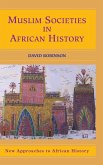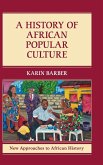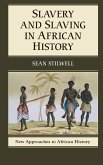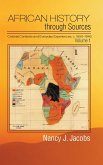This comprehensive and detailed exploration of the African past, from prehistory to approximately 1870, is intended to provide a fully up-to-date complement to the Cambridge History of Africa. Reflecting several emphases in recent scholarship, it focusses on the changing modes of production, on gender relations and on ecology, laying particular stress on viewing 'history from below'. A distinctive theme is to be found in its analyses of cognitive history. The work falls into three sections. The first comprises a historiographic analysis, and covers the period from the dawn of prehistory to the end of the Early Iron Age. The second and third sections are, for the most part, organised on regional lines; the second section ends in the sixteenth century; the third carries the story on to 1870. A second volume, now in preparation, will cover the period from 1870 to 1995. This book attempts a more rounded view of African history than most of the other textbooks on the subject addressed to a (largely) undergraduate level student. Earlier histories have tended to ignore some of the current foci in the scholarly literature on Africa, generally not reflected in the textbooks: these include discussions of topical issues like ecology and gender. Isichei's book is also more radical.
Table of contents:
Acknowledgements; Part I. Continental Perspectives: Perimeters: 1. Prelude: Africa and the historians; 2. Out of Africa: the precursors; 3. Environment, language and art c. 10,000-c. 500 BCE; 4. Producing more food c. 10,000-c. 500 BCE 5. Copper and iron c. 600 BCE-c. 1000 CE; 6. Models: Production, Power and Gender; Part II. Regional Histories to the Sixteenth Century: 7. Central Africa; 8. East Africa; 9. Africa south of the Limpopo; 10. Northern Africa in antiquity; 11. Northern Africa from the seventh century CE; 12. The North-East; 13; The Western Sudan; 14. West Africa: from the savanna to the sea; Part III. Regional Historis to c. 1870: 15. Northern Africa; 16. The Western Sudan; 17. The Central Sudan; 18. The Atlantic slave trade; 19. West Africa to 1870; 21. Central Africa; 22. Southern Africa; 23. East and East Central Africa Maps: 1. Human evolution: archaeological sites; 2. African language families; 3. Bantu Languages; 4. Cradles of domestication; 5. Central Africa; 6. Eastern Africa; 7. South Africa; 8. Northern Africa in antiquity; 9. Northern Africa (seventh to twelfth centuries); 10. Egypt and the Near East: Fatimids and Mamluks; 11. The North-East; 12. The Western Sudan (to c. 1600); 13. Lower Guinea; 14. The Western and Central Sudan: the nineteenth century; 15. Southern Africa: the nineteenth century 16. East and Central Africa: the nineteenth century. Diagrams: 1. Human evolution; 2. Long-term climate change; 3. African language families: Afroasiatic; 4. African language families: Nilo-Saharan; 5. African language families: Kordofanian and Niger-Congo.
This detailed exploration of the African past, from prehistory to about 1870, covers all facets of the continent's history. An up-to-date textbook, it offers an impressive survey of the current literature and reflects trends in recent scholarship. It focusses in particular on 'history seen from below', on changing modes of production, gender relations and on ecology.
An exploration of the African past, from prehistory to about 1870.
Hinweis: Dieser Artikel kann nur an eine deutsche Lieferadresse ausgeliefert werden.
Table of contents:
Acknowledgements; Part I. Continental Perspectives: Perimeters: 1. Prelude: Africa and the historians; 2. Out of Africa: the precursors; 3. Environment, language and art c. 10,000-c. 500 BCE; 4. Producing more food c. 10,000-c. 500 BCE 5. Copper and iron c. 600 BCE-c. 1000 CE; 6. Models: Production, Power and Gender; Part II. Regional Histories to the Sixteenth Century: 7. Central Africa; 8. East Africa; 9. Africa south of the Limpopo; 10. Northern Africa in antiquity; 11. Northern Africa from the seventh century CE; 12. The North-East; 13; The Western Sudan; 14. West Africa: from the savanna to the sea; Part III. Regional Historis to c. 1870: 15. Northern Africa; 16. The Western Sudan; 17. The Central Sudan; 18. The Atlantic slave trade; 19. West Africa to 1870; 21. Central Africa; 22. Southern Africa; 23. East and East Central Africa Maps: 1. Human evolution: archaeological sites; 2. African language families; 3. Bantu Languages; 4. Cradles of domestication; 5. Central Africa; 6. Eastern Africa; 7. South Africa; 8. Northern Africa in antiquity; 9. Northern Africa (seventh to twelfth centuries); 10. Egypt and the Near East: Fatimids and Mamluks; 11. The North-East; 12. The Western Sudan (to c. 1600); 13. Lower Guinea; 14. The Western and Central Sudan: the nineteenth century; 15. Southern Africa: the nineteenth century 16. East and Central Africa: the nineteenth century. Diagrams: 1. Human evolution; 2. Long-term climate change; 3. African language families: Afroasiatic; 4. African language families: Nilo-Saharan; 5. African language families: Kordofanian and Niger-Congo.
This detailed exploration of the African past, from prehistory to about 1870, covers all facets of the continent's history. An up-to-date textbook, it offers an impressive survey of the current literature and reflects trends in recent scholarship. It focusses in particular on 'history seen from below', on changing modes of production, gender relations and on ecology.
An exploration of the African past, from prehistory to about 1870.
Hinweis: Dieser Artikel kann nur an eine deutsche Lieferadresse ausgeliefert werden.








